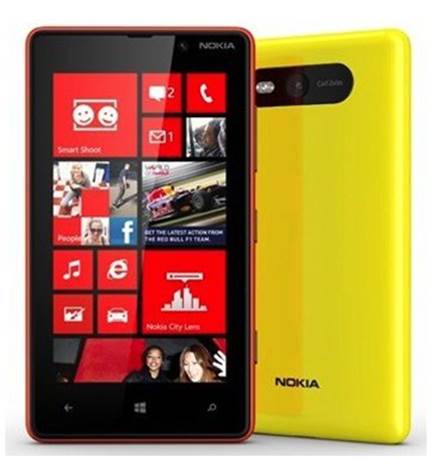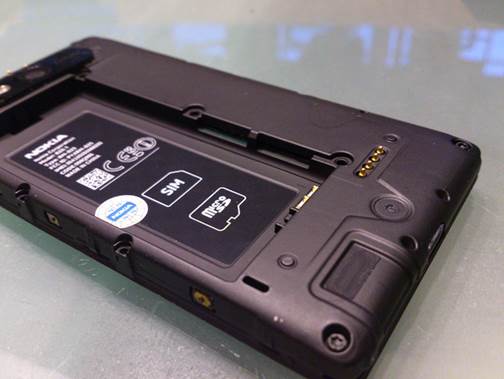Nokia Lumia 820 is a less expensive option
for the Windows phone crowd.
The Lumia 820 has got stuck behind the
shadow of its bigger brother since it was released, but if there are any phones
representing the vision of Windows Phone 8 different phones for different
people – that is this next - generation Lumia. Avoiding the family monolithic
design, this phone has an outer shell that can be disassembled and can work
with many types of housing: glossy, not glossy, super durable and capable of
wireless charging. It is a good option, providing a bit hardware customization
before you start tapping around the Live Tiles and customizing the color
schemes.

Nokia
Lumia 820
Under the lid, there is a removable 1,650mAh
battery, with access to the expandable microSD storage. The other
specifications consist of 1GB of RAM, the same 1.5GHz Snapdragon S4 processor
employed in the Lumia 920 and a 4.3-inch OLED screen, 800x480. Although with
the same ultra-sensitive capabilities available found on the other new Lumia.
On AT & T, it will cost $50 paying in advance, which is equal to half the
price of the 920, while in the UK, it costs $540 for a SIM-free version,
compared to $667.5 for the larger model. At this reduced price, you will not
have optical image stabilization system of sample Nokia, but you will still
have Carl Zeiss lens combined with an 8MP sensor. Therefore, there are some
understandable disadvantages compared to the Nokia’s standard phones and its
two greatest strengths, but how does Windows Phone 8 perform on a cheaper
phone? Join us to learn more about it.

Under
the lid, there is a removable 1,650mAh battery, with access to the expandable
microSD storage.
Hardware
The Lumia 820 has been craving for advertisements
at the epic conference event of Nokia and Microsoft, with the primary focus on
new technology was introduced to the Lumia 920. Is it unfair? Maybe a little,
and while the 920 was directed toward to the design philosophy of the older
Lumia phones, the 820 took the different method. The edges aren’t as rounded,
and while the phone is quite heavy with a thickness of 9.9mm, we had little
trouble while exploring the screen and handling the phone with one hand. With
5.64 ounces (160g), it is another heavy Nokia phone. In short, it is 15g
lighter than the 920, but still heavier than the HTC Windows Phone 8X and 8S.
It feels thicker, but based on the 4.87x2.7inch dimension, it is not as
difficult to use as the 920. However, more importantly, it is capable of Qi-
standard wireless charging beneath that color. While it is not pre-installed
into the hardware, it does not seem to add much to the weight or the thickness
of the shell and the device itself.
While we like the yellow glittering, the
soft wireless charging shell did not show the high-ranking feel we had from the
Lumia 920 a few weeks ago. It is not bad: the removable shell provides access
to the battery, and this is the first Windows Phone 8 that comes with microSD
expansion (supports memory cards up to 64GB), which means that you have more
time after filling 8GB built-in storage.
The design has nothing to blame, but to us,
it does not look like the Lumia. While the 920 is a part of Nokia’s
"Fabula" series, the phone's design can be compared to the Lumia 710.
The button layout goes after the Windows Phone template – there are three
capacitive buttons below the screen, with 3 physical plastic buttons along the
right edge. The two-stage camera button is rather over sensitive – the phone
often took photos when we just wanted to focus, which made you disappointed
when you were trying to capture those unexpected photos. Along the bottom edge,
you will find a micro-USB port next to a single speaker that is quite loud - we
just needed to type the middle settings for a pretty good playback volume. Just
on the screen, a VGA front-facing camera will be likely to handle video calls
(admittedly low resolution).
Inside, you will find connecting via NFC,
802.11a/b/g/n, Bluetooth 3.1 support and A-GPS as well as GLONASS - Nokia does
not take shortcuts with its positioning skills. The Lumia 820 does not skimp on
the radios either, with GSM/GPRS/EDGE (850/900/1800/1900MHz), UMTS/HSPA +
(850/900/1900/2100MHz) and (the 4G model) LTE (800/900/ 1800/2100/2600MHz)
bands. Unfortunately, there is no MHL support through the micro-USB port (and
no HDMI socket) so you would expect Microsoft's SmartGlass
application to accomplish your big-screen hopes and dreams.
However, there are some little touches that
made us disappointed, like the plastic surface is around the camera unit and
the physical buttons. There is no detail on the microphone here, while the big
screen includes the border around the AMOLED screen, the phone’s edge along
with the casing around it makes the phone look wider than it needs to be.
Screen
The Lumia 820 offers a 4.3inch screen, a
trivial 800x480 resolution; something is more appropriate with a
latest-generation Windows Phone, not the beginning of a new era plays role as a
potential third force in the smartphone world. Yes, it is an RGB Stripe AMOLED
screen, but they've recognized that the white colors are tinted a little slight
blue, especially when comparing it to the 8X HTC and Lumia 920. Nokia's
ClearBlack technology makes the black colors turn into black, but we think we
have seen something that is very similar (but not exact) on the Lumia 900 - it
has the same size, the same resolution and the same AMOLED technology.

The
Lumia 820 offers a 4.3- inch AMOLED screen.
While this is not entirely a bad thing,
based on outdoor admirable performance we saw there, we come back to the same
problems with the resolution that we had. We pointed out the lack of qHD or
720p resolution before Microsoft removes low resolution requirements of Windows
Phone, and 6 months later it is still a problem. Moreover, it's even more
prominent in front of its own PureMotion HD+ brother, and there is no reason to
justify when the phone is $50 cheaper than the Lumia 920. The Windows Phone
logos and Live Tiles look brushy on this screen, but the gap between the two
new Nokia smartphones is particularly prominent during web browsing and reading
on the screen on the Kindle app.
However, the Lumia 820 shows a better
viewing angle than the Lumia 920’s, which has a higher resolution (not AMOLED)
and the device is also processed with the same ultra-sensitive capacitive
screen technology, that means you will be able to navigate through Windows
Phone with gloves or even nails. However, you should know that the glass here
is only scratch-resistant; it is not strange toughened Gorilla Glass found on
the other phones of Nokia and on rival hardware, so we will refrain down our
enthusiasm to scratch it.